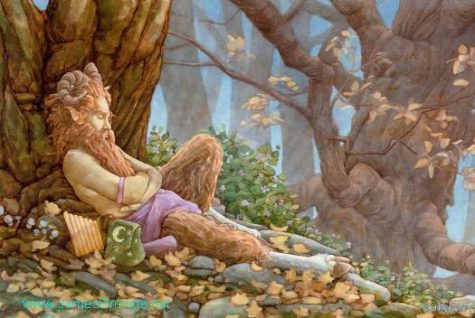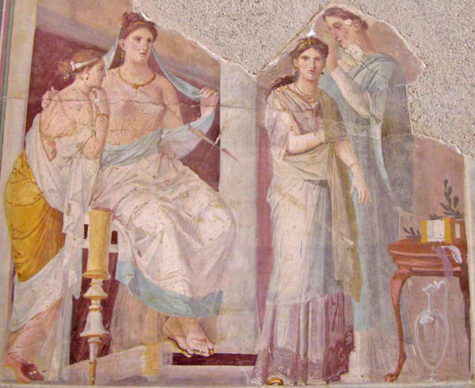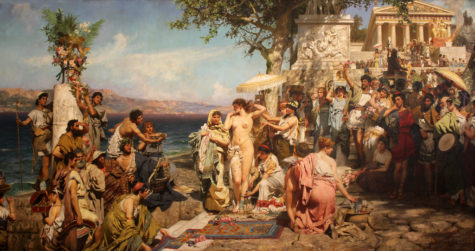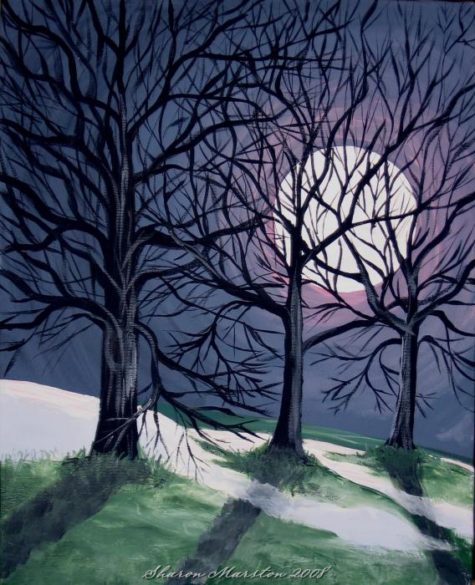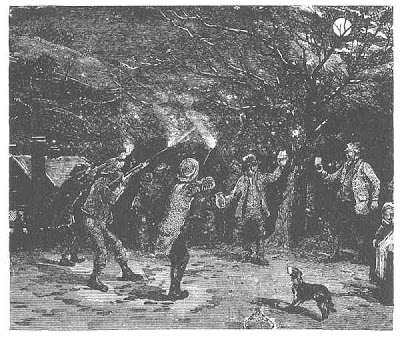Daily Archives: December 4, 2016
The 5thDecember was an ancient Roman festival, dedicated to Saturn’s grandson, Faunus, a god of the wildwood. The Romans celebrated Faunalia Rustica not in Rome but the countryside, so it is not registered in the calendars. However, it must have played a significant part in the lives of many Romans, especially in the early days.
In rural areas, individual farmers offered a libation of wine and sacrificed a young goat on the ancient altar made of sod. Horace recounts the peaceful holiday in one of his pastoral poems. The farmers relaxed and danced joyfully in the fields where they had labored so long and hard.
At Rome, there was a temple to Faunus on the Caelian Hill and another on Tiber Island, where the public ritual for the festival of Faunus (February 13) was conducted. However, the attempt to introduce the rural cult of Faunus into urban life was not very successful. Faunus remained chiefly a wild spirit of the countryside.
Faunus was an unpredictable deity who could cause havoc to those who farmed the land around his wildwoods. However, if correctly pacified, he could be helpful– especially during the winter season.
The name ‘Faunus’ comes from the root word favere or ‘kindly one.’ But Faunus could be anything but kindly. Dionysius also describes how his apparitions could inspire ‘terror.’ He could become an incubus, pursuing women through their dreams. He could also make life a misery for farmers around his groves.
If they were foolish enough to claim woodland as fields for their farms without first appeasing him, Faunus would appear as an apparition on the edge of the fields, haunting them.
But, by taking precautions and offering him sacrifices, it was possible to pacify and tame Faunus– for a while at least. Ovid describes how country folk would make the “the altars of rural Faunus smoke” with the sacrifices to ensure the god of the wildwood blessed their fields and livestock with fruitfulness– rather than persecuting and blighting them. The merry-making and sacrifices ensured his good offices over the winter months.
Horace’s Odes captures the essence of the festival and its rituals:
“O Faunus, thou lover of the flying nymphs, benignly traverse my borders and sunny fields and depart propitious to the young offspring of my flocks; if a tender kid fall [a victim] to thee at the completion of the year and plenty of wines be not wanting in the goblet, the companion of Venus and the ancient altar smoke with liberal perfume.
“All the cattle sport in the grassy plain when the nones of December return to thee; the village keeping holiday enjoys leisure in the fields, together with the oxen free from toil. The wolf wanders among the fearless lambs, the wood scatters its rural leaves for thee and the laborer rejoices to have beaten the hated ground in triple dance.”
The sacrifice of a goat kid and wine to the god, while villagers danced and celebrated among the autumn leaves, evoked a last festivity before the harshness of winter. But it was also essential to have Faunus’ good favor during the harsh winter season.
The country folk required Faunus’ guardianship of their flocks during the harsh winter months– as well as his good favor if they were to safely mine his woodlands for fuel and supplement their food.
Collected from various sources, including Decoded
The goddess Bona Dea also had a May festival, which is better known. The winter festival was held in December, at the home of the current senior annual Roman magistrate cum imperio, whether consul or praetor. It was hosted by the magistrate’s wife and attended by respectable matrons of the Roman elite. This winter festival is not marked on any known religious calendar but was dedicated to the public interest and supervised by the Vestals, and therefore must be considered official.
Men were not allowed to know Her name, never mind speak it, and they were also forbidden from Her secret festival. There were other taboos concerning the worship of the Bona Dea: neither wine nor myrtle were to be mentioned by name during Her secret festival, likely because they were both sacred to Her and therefore very powerful.
Shortly after 62 BC, Cicero presents it as one of very few lawful nocturnal festivals allowed to women, privileged to those of aristocratic class, and coeval with Rome’s earliest history.
Festival Rites:
The Winter festival is known primarily through Cicero’s account, supplemented by later Roman authors. First, the house was ritually cleansed of all male persons and presences, even male animals and male portraiture. Then the magistrate’s wife and her assistants made bowers of vine-leaves, and decorated the house’s banqueting hall with “all manner of growing and blooming plants” except for myrtle, whose presence and naming were expressly forbidden.
A banquet table was prepared, with a couch (pulvinar) for the goddess and the image of a snake. The Vestals brought Bona Dea’s cult image from her temple and laid it upon her couch, as an honored guest. The goddess’ meal was prepared: the entrails of a sow, sacrificed to her on behalf of the Roman people, and a libation of sacrificial wine.
The festival continued through the night, a women-only banquet with female musicians, fun and games, and wine; the last was euphemistically referred to as “milk”, and its container as a “honey jar”. The rites sanctified the temporary removal of customary constraints imposed on Roman women of all classes by Roman tradition, and underlined the pure and lawful sexual potency of virgins and matrons in a context that excluded any reference to male persons or creatures, male lust or seduction.
According to Cicero, any man who caught even a glimpse of the rites could be punished by blinding. Later Roman writers assume that apart from their different dates and locations, Bona Dea’s December and May 1 festivals were essentially the same.
Sources: Wikipedia and Thalia Took
Poseidon was once worshiped in every part of Greece as a God of general importance to the community. In ancient Greece, the feast day in his honor was widely celebrated at the beginning of the winter.
POSEIDO′NIA (ποσειδώνια), a festival held every year in Aegina in honour of Poseidon. It seems to have been celebrated by all the inhabitants of the island, as Athenaeus calls it a panegyris, and mentions that during one celebration Phryne, the celebrated hetaera, walked naked into the sea in the presence of the assembled Greeks. This was possibly because in Greek mythology, the sea god Poseidon is one of the most lascivious of the gods, producing more offspring than other note worthily randy gods.
Greek calendars vary from place to place, but in Athens and other parts of ancient Greece, there is a month that corresponds to roughly December/January that is named Poseideon for the sea-god Poseidon. The month of Poseidonia’s most anticipated and most important festival is the feast of the Poseidonia, a winter festival in honor of Poseidon. Since Poseidon is a sea god it is curious that his festival would be held during the time the Greeks were least likely to set sail.
It was celebrated with the pouring and drinking of wine, merriment, bonfires, and most likely a form of gift giving. Not much more is known about the way it was celebrated.
On a larger scale, “there was a festival once every fifth year at Sunium in honor of Poseidon – evidently, then, a major event. Also, animal offerings to Poseidon were a common feature at the feast days of other gods, including the “festival at the temple of Hera on the 27th of Gamelion,” which honored the goddess “together with Zeus the Accomplisher, Kourotrophos and Poseidon.”
Related Festivals:
- Haloea – Jan 8 thru 9th
- Poseidonia of Aegina – A Midwinter Festival lasting as long as 2 months
Collected from various sources
The last moon phase of the year is the Big Winter Moon in December, also called Long Nights Moon, or the Cold Moon.
Correspondences:
- Colors: White, red, and black
- Gemstones: Obsidian, ruby, serpentine
- Trees: Pine, holly
- Gods: Minerva, Osiris, Athena, Persephone and Hades
- Herbs: Ivy, mistletoe, holly and berries, cinnamon
- Element: Fire
As the days get shorter and Yule approaches with the longest night of the year, we force ourselves to get through the darkness because eventually we will see the sunlight and warmth again. Think about the things in your life that you’ve had to endure. Sometimes, a part of us must die in order to be reborn. Now is the perfect time for spiritual alchemy — time to evaluate your life, and know that you’ll survive the dark times.
If you’ve already put the darkness behind you, take your good fortune and share it with others. When it’s cold outside, open your heart and home to friends and family. Reach out to people who might be suffering from the chill of winter, either spiritually or physically.
source: about.com
What follows is a list (in alphabetical order) of the names given to the December moon. Also listed is the tradition and/or origin of that moon name:
- Aerra Geola ~other
- Ashes Fire Moon ~San Juan
- Before Yule Moon ~Cherokee
- Big Bear’s Moon ~Winnebago
- Big Winter Moon ~Creek
- Bitter Moon ~Chinese
- Cold Moon ~Algonquin, Celtic
- Cold Time Moon ~Mohawk
- Deer Horn Shedding Moon ~Sioux
- Frost Fish Moon ~Passamaquoddy
- Heavy Snow Moon ~other
- Kaitvitjuitk ~Inuit
- Little Finger Moon ~other
- Long Nights Moon ~Algonquin
- Mid-Winter Moon ~other
- Night Moon ~Taos
- Oak Moon ~Janic (full), Medieval English
- Peach Moon ~Choctaw
- Popping Trees Moon ~Sioux, Arapaho
- Real Goose Moon ~Kiowa
- Respect Moon ~Hopi
- Running Wolves Moon ~Cheyenne
- Small Spirits Moon ~other
- Snow Moon ~Cherokee, Janic (dark)
- Turning Moon ~other
- Twelfth Moon ~Dakotah
- Under Burn Moon ~other
- Winter Maker Moon ~other
- Wintermonat Moon ~other
- Wolf Moon ~other
- Yellow Leaves Moon ~other
Wassailing the trees occurred on old “twelfth night”, the 12th night after Christmas eve, or January 17th on the old calendar. (Other calendars show the date as January 5th.)
Obviously traditions varied, but in Devonshire, Herefordshire and in other parts of the West Country of England (as well as elsewhere no doubt) families would hold a feast with cakes, cider and in some areas beer and ale too. After a time of eating and drinking everyone trooped out to the orchard to wassail the trees, and wake them up from winter for the coming season as well as scare off any bad energy, spirits or demons.
Ale, beer or cider soaked toast, in some areas special cakes, would be placed in the tree branches or in a fork of the tree, and then be splashed with more cider. Trees might be beaten with sticks, pounded on, pots and pans clanged, and in appropriate eras, guns that had been loaded with just powder (no shot) would be fired at the trees.
While this went on, others in the group bowed their heads and sang the special “wassail song”.
Variations include:
Old apple tree, we’ll wassail thee
And hoping thou wilt bear
The Lord does know where we shall be
To be merry another year.
To blow well and to bear well
And so merry let us be
Let every man drink up his cup
And health to the old apple tree
(Spoken)
Apples now, hat-fulls, three bushel bag-fulls,
tallets ole-fulls, barn’s floor-fulls,
little heap under the stairs
Hip Hip Hooroo
Hip Hip Hooroo
Hip Hip Hooroo
source: Folk Info
